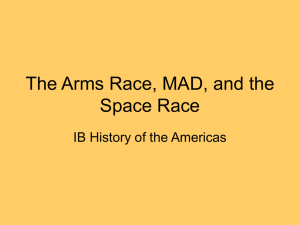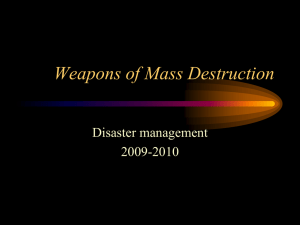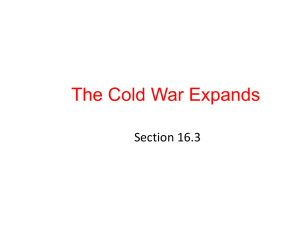Nuclear Arms Race and Star Wars
advertisement
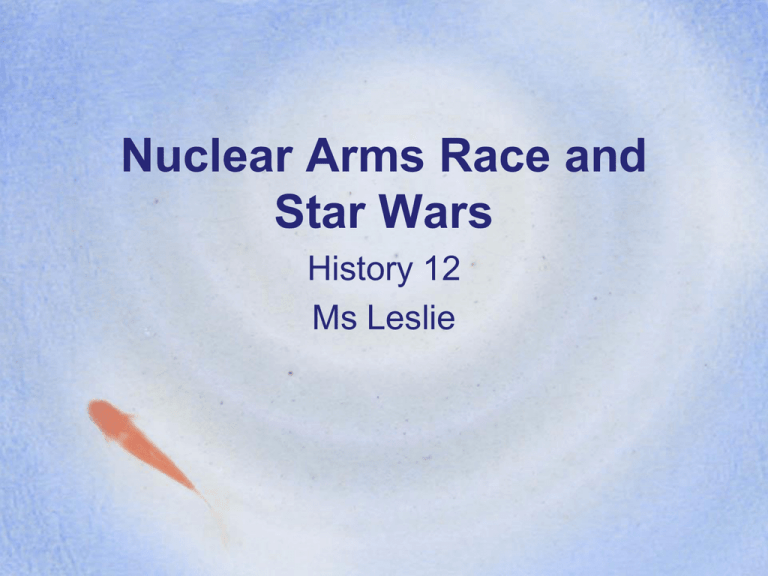
Nuclear Arms Race and Star Wars History 12 Ms Leslie 1940’s - 50’s • Allied powers were the first to have the bomb. • Churchill and Eisenhower came to the agreement that if the USSR attacked then there would be the ‘Doctrine of Massive Retaliation’ where the USSR would simply be destroyed by nuclear weapons. • This policy was in effect until the Soviets had the bomb • Soviets kept a large standing army to counter until they had the bomb in 1949. • The UN tried to place controls on Nuclear power with the Baruch plan Baruch plan • called for international management of the raw materials and inspection by international management of facilities. • no vetoes in the UN on these policies and majority rule in decision making. • The USSR rejected this plan as it would restrict them as to where and how they could build their nuclear facilities. • They countered with a demand of the destruction of all nuclear bombs and the cessation of production. This was rejected by the Americans. Nuclear strategy = deterrence • Now each side built up an arsenal to survive the first attack. • The goal of a nuclear war would be to destroy the opponent before they destroyed you. • The theory is that the possession of Nuclear weapons would make war unthinkable. 1960’s • The relation between the USSR and the USA in the 1960’s to 1979 is known as Detente this is characterized by the relaxing of tension and the better relations between the two powers. • Detente was seen as necessary because of the parity of their nuclear arsenals after the Cuban Missile Crisis. 2 justifications for nuclear build up 1. the growth in enemy stocks required a balanced growth in one’s own arsenal to ensure parity. There also had to be continual refinement of delivery systems to ensure that the threat of retaliation remained a credible one. 2. A wide variety of nuclear weapons systems were now required to ensure maximum flexibility in responding to any situation, from a localized tactical affair with battle field weapons to an all out holocaust. July 1969 – Lunar Landing mid 1970’s • weapons were developed in secret under ground or under the sea with nuclear powered submarines. • Both side invested in early-warning radar systems, anti-missile systems and cluster rockets. The Strategic Defense Initiative (SDI): • Also referred to as ‘Star Wars’ as it came out at the same time as the movie • The American system would destroy Soviet missiles in space before they reached their destination. • Gorbachev said this would only make the Soviets make their own SDI and thus make the arms race continue. • SDI would be a defensive shield to prevent enemy missiles from penetrating • Not only can an effected system prevent a first strike, it can also provide protection against a retaliatory strike after the enemy has been hit. • This is why the Soviets are wary of SDI Is it feasible? no • Most scientists agreed that there is little hope of developing an effective protective shield. • Despite billions of American dollars being spent, it is an impossible task to prevent an entire attack. Why not? • Part of the problem is that we don’t even know much about the weapons we would be protected against. No above ground testing of bombs has taken place since the early 1960’s. • It is also impossible to predict how an enemy will attack. • Often times is it relatively low-tech counter measures that defeat high-tech defenses. Nuclear Proliferation • First the USA, then the USSR, then the British, French and Chinese joined the ‘nuclear club’. • Their justifications mirrored each other – these weapons systems were purely defensive and intended to promote peace. 1968 Nuclear NonProliferation treaty • A success of Detente • President Johnson’s initiative • To not share information about Nukes to others. • 1968 signed by USA and USSR and UK • 1975 – 93 countries signed, but not France, China, Egypt, Japan, Israel or South Africa. • Doesn’t really matter as countries have made bombs all on their own • India - 1974 • Israel - 1979 • Pakistan - 1998 • North Korea - 2006 (oh boy) Arms limitation agreements • Cuban missile crisis alerted world for need for limits • Did not want accidental nuclear war • Started with the red phone 1963 - Test Ban Treaty • this ended aboveground testing of nuclear weapons. • Though France and China refused to sign, the practice of limiting tests to underground locations was ultimately accepted. Strategic Arms Limitations Talks (SALT 1) • In 1969 in Helsinki • limits number of intercontinental ballistic missiles. • Both sides ultimately agreed to limit the number of launchers that they might employ. Though the limits were very high, it was a good initial step. • Unfortunately, technology ran ahead of the agreement and soon new weapons, particularly in multiple warheads, mobile launchers and cruise missiles, would cause further destabilization. • SALT 1 was extended in Moscow in 1972 and Vladivostok in 1975 as first Nixon, then Ford came to further agreements with Brezhnev. • President Carter and Brezhnev came to an even more comprehensive treaty in 1979, in Vienna, SALT 2. SALT 2 • to achieve nuclear parity • Didn’t work because: 1. Soviets invaded Afghanistan – President Carter put SALT 2 on hold 2. NATO added cruise missiles to it’s arsenal 3. Reagan took office and called the USSR and ‘evil empire’ and the vowed the USA would always be stronger, refused to sign the treaty and renewed the arms race. 1975 – Helsinki Accords • Most significant accomplishment of detente. • August – USA, USSR, France and UK with 31 other nations met and agreed to the following: o Acceptance of Europe’s bordered including a divided Germany o Respect Human Rights o Allow easier immigration 1980’s • Saw a renewed arms race after the collapse of SALT 2 • Focused on Number and size of weapons as well as new technology. • America was the leader in new guidance systems and attack missiles completely controlled by computers. • The Cruise Missile • USSR and USA had them • A pilotless, small airplane with nuclear firepower • Follows an on-board computer program to get to its target • Flies at low altitude to make it invisible to radar. • Smart Weapons – Targeted and controlled by computers. – Seen in the Gulf War – pilots are not needed on board. – Technology used in tanks as well – USA the leader in this technology • There were attempt to control the arms race in the 1980’s • 1982 was the Strategic Arms Reduction Talks (START) the terms favoured the Americans so the Soviets would not agree to it. • not signed until 1991 • At the same time Reagan ordered the manufacture of ‘enhanced radiation’ bombs (neutron bomb) which would kill with radiation rather than explosive blast. 1985 • Gorbachev comes in to power in the USSR. • He wanted better relations with the West and Reagan was in the last 5 years of his presidency and wanted to look good. • 1985, November Geneva – Both agreed nuclear war was not winnable • 1986, October, Reykjavik – Gorbachev wants to dramatic decease in arsenal and Reagan to kill the SDI – Reagan refused • 1987, December, Washington – Agree to destroy all ground based nuclear forces – Changed the direction of the Cold War • 1988, May, Moscow – Focused on human rights • 1988, December, New York – Gorbachev promises the UN to reduce number of troops and equipment – Afghanistan at an end – This relied heavily on Gorbachev’s domestic agenda • End :)


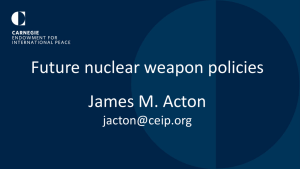

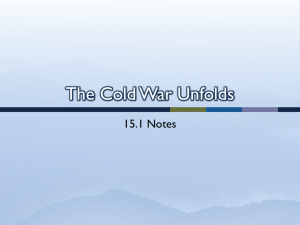
![The Politics of Protest [week 3]](http://s2.studylib.net/store/data/005229111_1-9491ac8e8d24cc184a2c9020ba192c97-300x300.png)

